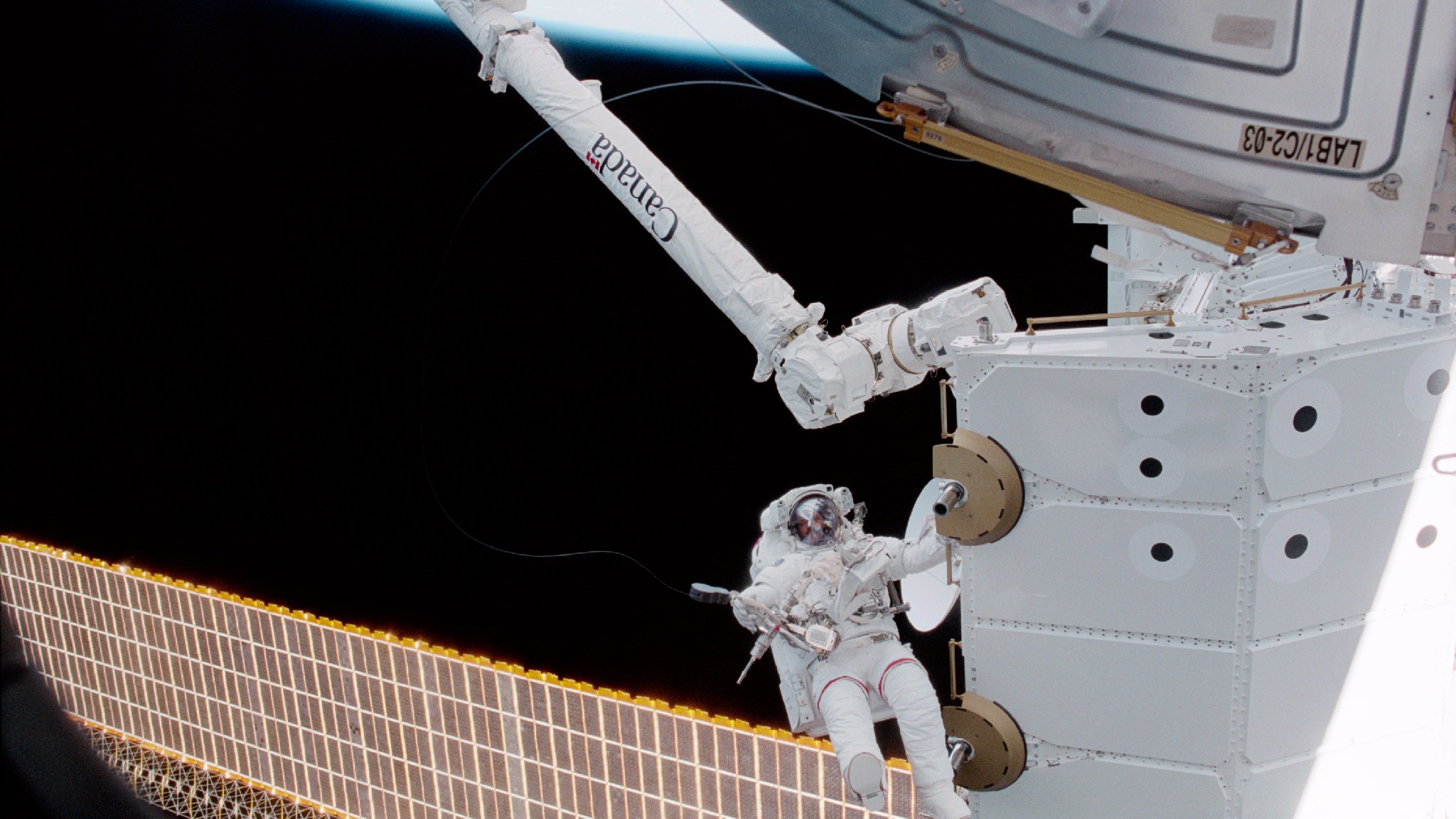A Canadian robotic arm on the Worldwide House Station is days from a giant milestone.
MDA House’s Canadarm2 will have a good time its fiftieth cosmic catch no sooner than Aug. 5, when a Northrop Grumman Cygnus cargo ship berths with the Worldwide House Station (ISS) with hundreds of kilos of experiments, provides and meals for the Expedition 71 astronauts, the Canadian House Company (CSA) introduced right this moment (Aug. 2).
Cygnus will launch to the ISS no sooner than 11:29 a.m. EDT (0329 GMT) on Aug. 3, and you’ll watch the mission right here at House.com, courtesy of NASA+, previously NASA Tv. If Cygnus launches on time, can be captured by Canadarm2 and can dock with the ISS on Aug. 5 at roughly 3:55 a.m. EDT (0755 GMT). Protection will begin at 2:30 a.m. EDT (0630 GMT) on NASA+.
Canadarm2, managed by MDA House below CSA funding, was first launched to area April 19, 2001 on area shuttle mission STS-100. Mission astronaut Chris Hadfield carried out the first-ever CSA spacewalks to put in the arm, a milestone celebrated by enjoying the Canadian nationwide anthem in area and jokingly referring to fellow spacewalker Scott Parazynski (of NASA) as “an honorary Canadian.”
The arm’s first spacecraft catch was on Sept. 17, 2009 when it captured Japan’s HTV-1 (“HTV”, a now-retired cargo spacecraft collection, stood for H-II Switch Car). Within the 15 years since, spacecraft berthing with Canadarm2 ranged from SpaceX‘s Cargo Dragon to Northrop Grumman’s Cygnus.
Canadarm2 types a part of a collection of Canadian robotic arms primarily based on generations of telescoping tube expertise seen in area examples starting from extendable antennas to the Apollo program’s lunar legs, in line with “Canadarm and Collaboration” (Elizabeth Howell, ECW Press, 2020.)

Canadarm was first flown in area Nov. 12, 1981 throughout shuttle mission STS-2 with Spar Aerospace and Canada’s Nationwide Analysis Council (the federal government council that managed astronauts earlier than the CSA was shaped in 1989). Canadarm was used for spacewalking, a number of Hubble House Telescope missions and a few impromptu maneuvers akin to knocking an ice plug off a frozen shuttle drain line, in line with NASA.
Canadarm’s success in area allowed the NRC, after which CSA, to pay for astronaut seats on the shuttle because the robotic arm supplied a web profit to NASA actions in orbit. (The primary Canadian astronaut, then with NRC, was Marc Garneau aboard STS-41G in October 1983.) That astronaut association has continued to the current day, and can proceed with the long run Artemis program missions to the moon.
Associated: Artemis 2’s Canadian astronaut obtained their moon mission seat with ‘potato salad’

MDA House (then MDA) introduced the area robotics division of Spar Aerospace in 1999, in line with the Nationwide Put up. MDA House’s Canadarm2 has been operational since 2001, starring in a difficult and near-emergency spacewalk by Parazynski in 2007 that noticed him mend a torn photo voltaic panel with tailored instruments.
Canadarm2 extra usually helped construct the ISS alongside Canadarm, and continues to function in ISS upkeep spacewalks. A CSA-funded robotic helper by MDA House, Dextre, launched in 2008 for extra delicate ISS upkeep duties.
Lately, the Canadarm2 crew has gained a lot belief with NASA that many duties at the moment are licensed to be carried out in floor management amenities at CSA headquarters close to Montreal, Quebec. And CSA was invited to hitch Artemis in 2019 by supplying a brand new robotic arm, Canadarm3. MDA House obtained a collection of Canadarm3 contracts and is finalizing its design for an anticipated 2029 launch to assist NASA’s Gateway area station on the moon.
NASA was stalwart in saying the CSA was recognized for its dependable aspect dish of robotics, Podwalski advised House.com in 2023. Robotics is a strategic spend on the a part of an area company that has a tiny, $300 million ($413 million CAD) annual finances relative to NASA’s $25.4 billion in 2025. Apart from area, robotics will also be repurposed for medical and mining wants in distant areas of Canada, making it another excuse to put money into the expertise.

Canadarm3 funded CSA astronaut Jeremy Hansen‘s round-the-moon seat aboard the Artemis 2 mission, making him the primary Canadian to go away low Earth orbit. His 2025 mission with three NASA astronauts would be the first of an anticipated collection of CSA Artemis missions to Gateway and maybe to the moon’s floor itself.
Ken Podwalski, CSA government director of the Gateway program, has been commanding Canadian area robotics for many of his profession. He was concerned within the negotiations for Hansen’s seat, which took 4 years to acquire as each NASA and CSA coverage priorities needed to align on the matter, and funding to be obtained.
In an interview, Podwalski likened the CSA robotics to unimaginable “potato salad” created to enhance different principal dishes in a feast.
“All people expects Canada to carry the potato salad,” Podwalksi advised House.com 2023, shortly earlier than Hansen’s seat was introduced that April 3. And he mentioned it was doable to construct up different moon packages from that: “The potato salad will get you within the door, no downside […] and it would not cease you from bringing the rest. You are now part of the celebration. Now’s a great time to carry up different issues.”
To make sure, CSA has different technique of funding past its annual finances: it companions with different Canadian authorities companies and with trade to stretch its {dollars} additional, for instance. It has additionally obtained repeated billion-dollar-scale infusions of one-time authorities funding for Artemis in recent times.
CSA’s different moon contracts embody funding a mini-rover for science and utility rover for Artemis astronaut cargo, in addition to a collection of moon-related applied sciences significantly targeted on moon science, astronaut well being and acceptable deep-space meals.



